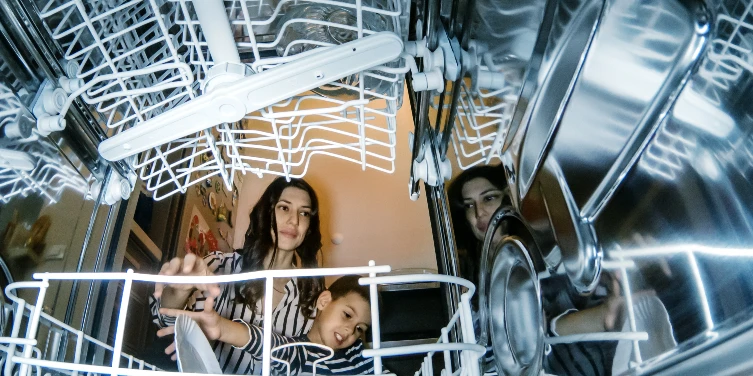You're Loading Your Dishwasher Wrong & Your Dishes Aren't as Clean as They Could Be
How & Why Your Process Matters
Wait, there’s a wrong way to load the dishwasher? It might surprise some that, while there isn’t necessarily a wrong way, there are most definitely some methods that are much more effective than others at getting your dishes squeaky clean.
If you’ve ever tried to empty the dishwasher only to have to put several dishes back in for another wash, consider how you’re currently loading everything in — there may be a better way.
How Dishwashers Work
Once you’ve gotten your dishes and soap loaded into the dishwasher and you press start:
- A small basin at the bottom of the dishwasher fills with water
- A heating element warms the water up to 155 degrees Fahrenheit
- The detergent mixes in with the water as it heats up
- A pump pushes the soapy water up to the spray arms at the top of the machine
- The pressure from the pump moves the spray arms as they jet out water
- Food particles are either chopped up (like a garbage disposal) or captured in a filter
- This heating, spraying, and catching food process repeats several times
- The water drains out, and if you’ve selected a dry cycle, the heating elements warm the air to dry the dishes
You should place your dishes with some thought to ensure the soapy water from the jets thoroughly cleans the surface. And it’s very important to consider the location of the heating element to avoid ruining any dishes with excess heat.
We’ll start with an obvious ‘what not to do’: Don’t blindly toss everything into your dishwasher until it’s overflowing, before shoving it shut like a stuffed suitcase and running the cycle.
Now, let’s go through the upper rack, lower rack, silverware, and what shouldn’t go in the dishwasher.
Dishwasher Loading: Top Rack
Since the top rack is furthest from the heating element and water must propel upwards to function, it provides the gentlest clean. That means your fragile dishes should be on top:
- Cups
- Mugs
- Bowls
Everything in the top of the dishwasher should sit at an angle to get the best access from the jets and allow for water runoff.
Dishes should have some space between them so the water can properly access everything. Avoid overlapping bowls, as this can lead to chips and cracks from water pressure.
Dishwasher Loading: Bottom Rack
Did you know that everything should face the center on the lower rack of your dishwasher?
The bottom rack is where you’ll want to place your:
- Plates
- Pots
- Pans
- Large Dishes
Though they perform similar functions, dishwashers come with various features to choose from. This is something to keep in mind as you’re loading dishes because you’ll want to be aware of the heating element, soap dispenser, and spray arm location.
The spray arm must be able to circulate, and the dispenser needs to open at the correct time. And the heating element should never have fragile dishware close to it. Anything large should go close to the back of your dishwasher so that it does not block the detergent dispenser from opening.
Unlike the top rack, bowls on the lower level should go on their side for a better water flow.
Dishwasher Loading: Silverware
Depending on how your silverware basket is set up, you may have cell covers in place to help keep cutlery separated.
If your basket does not have covers, alternate the way your silverware is facing to avoid overlap. And you can mix up whether your silverware is facing up or down. The only exception to this is knives, which you should have face-down for safety.
Lastly, don’t load silver next to stainless steel — if the two metals touch throughout the washing process, it can cause a reaction that corrodes the steel.
What Shouldn’t Go in The Dishwasher?
Many times, you’ll find a sticker on an item stating that it’s dishwasher safe. But this isn’t the case for all materials, which is when it’s good to have a rule of thumb to follow.
There are specific materials to avoid putting in your dishwasher, such as:
- Cast Iron
- Wood
- Crystal
- Brass
- Bronze
- Pewter
- Aluminum
The reason for washing these materials by hand instead of tossing them into the dishwasher is that they cannot handle the amount of heat that the dishwasher can produce. So, it’s better to be safe than sorry! To continue learning how you can improve the efficiency of your appliances, check out these recommendations by Mr. Appliance.
 Click to call
Click to call



